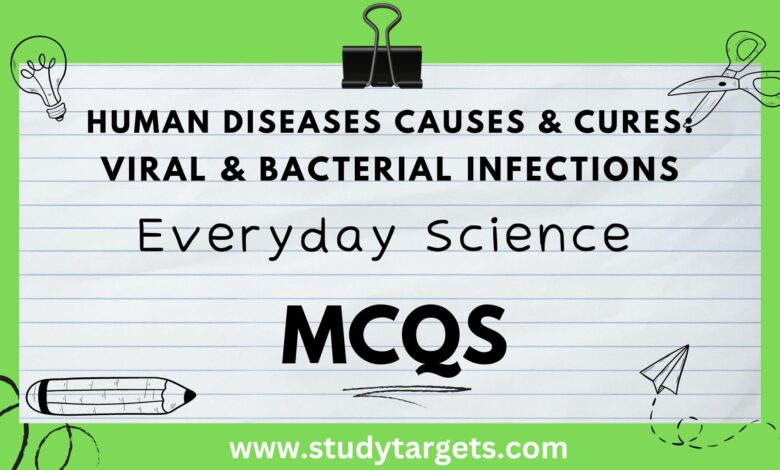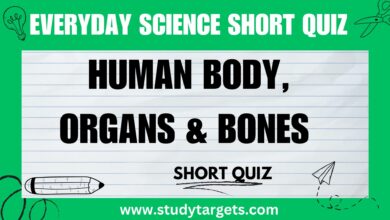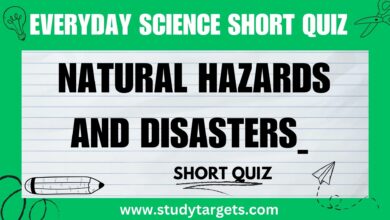MCQs: Human Diseases Causes and Cures:Viral ,Epidemics,Pandemics:Everyday Science MCQs

Human Diseases & Causes
1. What is the uncontrolled growth of abnormal cells in the body, leading to the formation of tumors?
a) Tuberculosis
b) Malaria
c) Cancer
d) Diabetes
Answer: c) Cancer
2. Which type of cancer affects the blood and bone marrow, leading to abnormal production of blood cells?
a) Leukemia
b) Breast cancer
c) Lung cancer
d) Prostate cancer
Answer: a) Leukemia
3. What is the infectious disease caused by Mycobacterium tuberculosis, primarily affecting the lungs but can also affect other parts of the body?
a) Influenza
b) Tuberculosis (TB)
c) Hepatitis
d) Cholera
Answer: b) Tuberculosis (TB)
4. Which type of cancer originates in the skin cells and is often associated with exposure to ultraviolet (UV) radiation?
a) Lung cancer
b) Melanoma
c) Colon cancer
d) Pancreatic cancer
Answer: b) Melanoma
5. What is the most common type of cancer in women, usually forming in the milk ducts or lobules of the breast?
a) Ovarian cancer
b) Cervical cancer
c) Breast cancer
d) Uterine cancer
Answer: c) Breast cancer
6. Which infectious disease is caused by the human immunodeficiency virus (HIV), leading to a weakened immune system?
a) Hepatitis
b) Malaria
c) Tuberculosis
d) Acquired Immunodeficiency Syndrome (AIDS)
Answer: d) Acquired Immunodeficiency Syndrome (AIDS)
7. What is the type of cancer that starts in the cells of the lungs and is often associated with smoking?
a) Liver cancer
b) Lung cancer
c) Pancreatic cancer
d) Brain cancer
Answer: b) Lung cancer
8. Which type of cancer affects the colon or rectum, and early detection can be achieved through regular screenings like colonoscopy?
a) Breast cancer
b) Colon cancer
c) Leukemia
d) Prostate cancer
Answer: b) Colon cancer
9. What is the chronic inflammatory lung disease that narrows the airways and makes breathing difficult?
a) Asthma
b) Tuberculosis
c) Emphysema
d) Pneumonia
Answer: a) Asthma
10. Which type of cancer affects the prostate gland in men and is one of the most common cancers in males?
a) Prostate cancer
b) Liver cancer
c) Brain cancer
d) Ovarian cancer
Answer: a) Prostate cancer
11.Which of the following diseases is caused by a virus?
a) Malaria
b) Tuberculosis
c) Cholera
d) Influenza
Answer: d) Influenza
12. Which disease is characterized by the inflammation of the airways, leading to difficulty breathing and coughing?
a) Pneumonia
b) Asthma
c) Bronchitis
d) Influenza
Answer: b) Asthma
13. What is the main mode of transmission for the Ebola virus?
a) Mosquito bites
b) Contaminated food and water
c) Airborne droplets
d) Contact with infected bodily fluids
Answer: d) Contact with infected bodily fluids
14. Which of the following is a bacterial infection that primarily affects the lungs?
a) Hepatitis B
b) Tuberculosis
c) HIV/AIDS
d) Malaria
Answer: b) Tuberculosis
15. What is the causative agent of COVID-19, the disease responsible for the 2019-2021 pandemic?
a) Influenza A virus
b) SARS-CoV-2
c) HIV
d) Ebola virus
Answer: b) SARS-CoV-2
16. Which disease is transmitted by the Aedes mosquito and causes symptoms like fever, joint pain, and rash?
a) Malaria
b) Dengue fever
c) Cholera
d) Measles
Answer: b) Dengue fever
17. The common cold is usually caused by which type of virus?
a) Influenza virus
b) Coronavirus
c) Rhinovirus
d) Varicella-zoster virus
Answer: c) Rhinovirus
18. What is the primary mode of transmission for the Zika virus?
a) Mosquito bites
b) Contaminated food and water
c) Airborne droplets
d) Sexual contact
Answer: a) Mosquito bites
19. Hepatitis B is a viral infection that primarily affects which organ?
a) Heart
b) Liver
c) Lungs
d) Kidneys
Answer: b) Liver
20. Which of the following diseases is caused by a parasitic protozoan transmitted through the bites of infected female Anopheles mosquitoes?
a) Tuberculosis
b) Cholera
c) Malaria
d) Dengue fever
Answer: c) Malaria
21. Which disease is caused by the bacterium Vibrio cholerae and leads to severe diarrhea and dehydration?
a) Influenza
b) Tuberculosis
c) Cholera
d) Malaria
Answer: c) Cholera
22. What is the primary mode of transmission for HIV, the virus responsible for AIDS?
a) Mosquito bites
b) Airborne droplets
c) Sexual contact
d) Contaminated food and water
Answer: c) Sexual contact
23. Measles is a highly contagious viral disease that primarily affects which body system?
a) Respiratory system
b) Digestive system
c) Nervous system
d) Immune system
Answer: a) Respiratory system
24. Which disease is caused by the bacterium Mycobacterium leprae and mainly affects the skin and nerves?
a) Leprosy
b) Tuberculosis
c) Influenza
d) Cholera
Answer: a) Leprosy
25. Which of the following diseases is primarily transmitted through contaminated food and water, causing symptoms like diarrhea and vomiting?
a) Influenza
b) Tuberculosis
c) Cholera
d) Malaria
Answer: c) Cholera
26. What is the common name for Varicella-zoster virus, which causes chickenpox during the initial infection and shingles later in life?
a) Measles virus
b) Herpes simplex virus
c) Human papillomavirus
d) Epstein-Barr virus
Answer: b) Herpes simplex virus
27. Which disease is caused by the bacterium Yersinia pestis and is commonly associated with fleas and rodents?
a) Typhoid fever
b) Bubonic plague
c) Syphilis
d) Cholera
Answer: b) Bubonic plague
28. Polio is a viral infection that primarily affects which part of the body?
a) Heart
b) Lungs
c) Nervous system
d) Liver
Answer: c) Nervous system
29. Which disease is caused by the human immunodeficiency virus (HIV) and leads to a weakened immune system?
a) Tuberculosis
b) Influenza
c) HIV/AIDS
d) Dengue fever
Answer: c) HIV/AIDS
30. Which of the following diseases is caused by a bacterium called Mycobacterium tuberculosis and primarily affects the lungs?
a) Tuberculosis
b) Cholera
c) Influenza
d) Malaria
Answer: a) Tuberculosis
31.Which disease is caused by the bacterium Clostridium tetani and is characterized by muscle stiffness and spasms?
a) Tetanus
b) Pertussis (Whooping cough)
c) Mumps
d) Rubella (German measles)
Answer: a) Tetanus
32. Which viral disease is transmitted through the bite of an infected animal, causing symptoms like fever, headache, and muscle pain?
a) Rabies
b) Lyme disease
c) Chikungunya
d) Zika virus disease
Answer: a) Rabies
33. What is the primary mode of transmission for the SARS-CoV (Severe Acute Respiratory Syndrome) virus during the 2002-2003 outbreak?
a) Mosquito bites
b) Airborne droplets
c) Contact with infected bodily fluids
d) Consumption of contaminated food
Answer: b) Airborne droplets
34. Which disease is caused by the bacterium Bacillus anthracis and can affect both humans and animals?
a) Anthrax
b) Leprosy
c) Cholera
d) Typhoid fever
Answer: a) Anthrax
35. Which of the following diseases is characterized by inflammation of the liver and can be caused by various viruses, including Hepatitis A, B, and C?
a) Hepatitis
b) Cholera
c) Tuberculosis
d) Malaria
Answer: a) Hepatitis
36. What is the main mode of transmission for the H5N1 avian influenza virus (bird flu) to humans?
a) Mosquito bites
b) Airborne droplets
c) Contact with infected birds or surfaces
d) Consuming undercooked poultry products
Answer: c) Contact with infected birds or surfaces
37. Which viral disease is transmitted through the bite of an infected mosquito and can cause severe birth defects in newborns if contracted during pregnancy?
a) Measles
b) Zika virus disease
c) Chickenpox
d) Typhoid fever
Answer: b) Zika virus disease
38. Which disease is caused by the bacterium Clostridium botulinum and leads to muscle weakness and paralysis?
a) Botulism
b) Mumps
c) Pertussis (Whooping cough)
d) Rubella (German measles)
Answer: a) Botulism
39. What is the primary mode of transmission for the H1N1 influenza virus (swine flu) during the 2009 pandemic?
a) Mosquito bites
b)Airborne droplets
c) Contact with infected pigs
d) Consuming undercooked pork products
Answer: b) Airborne droplets
40. Which of the following diseases is caused by the bacterium Yersinia pestis and is transmitted through the bites of infected fleas?
a) Cholera
b) Typhoid fever
c) Syphilis
d) Bubonic plague
Answer: d) Bubonic plague
Cures:
41. What is the ultimate goal of medical research in tackling diseases?
a) Developing effective vaccines
b) Identifying disease risk factors
c) Discovering disease cures
d) Providing palliative care
Answer: c) Discovering disease cures
42. Which of the following factors plays a crucial role in finding cures for diseases?
a) Availability of over-the-counter medications
b) Government funding for research
c) Use of complementary medicine
d) Internet self-diagnosis
Answer: b) Government funding for research
43. What term describes the process of conducting experiments and studies to evaluate potential disease treatments?
a) Placebo effect
b) Clinical trials
c) Home remedies
d) Alternative therapies
Answer: b) Clinical trials
44. Which of the following statements is true regarding disease cures?
a) All diseases have known cures
b) Disease cures are available only for infectious diseases
c) Disease cures are developed through scientific research and testing
d) Disease cures are primarily based on folklore and superstitions
Answer: c) Disease cures are developed through scientific research and testing
45. What is the term for a substance that stimulates the body’s immune system to produce a protective response against a disease-causing agent?
a) Antibiotic
b) Antiviral
c) Vaccine
d) Analgesic
Answer: c) Vaccine
46. Which branch of medicine focuses on developing personalized treatments for specific individuals based on their genetic makeup?
a) Oncology
b) Immunology
c) Pharmacology
d) Precision medicine
Answer: d) Precision medicine
47. Which of the following factors can contribute to the challenges in finding cures for certain diseases?
a) Lack of access to medical facilities
b) Genetic predisposition
c) Environmental factors
d) All of the above
Answer: d) All of the above
48. What is the term for a medical procedure that replaces a diseased organ with a healthy one from a donor?
a) Vaccination
b) Transplantation
c) Chemotherapy
d) Radiotherapy
Answer: b) Transplantation
49. What role does early diagnosis play in the effectiveness of disease treatments?
a) Early diagnosis does not impact treatment outcomes
b) Early diagnosis increases treatment success rates
c) Early diagnosis leads to more severe symptoms
d) Early diagnosis is not essential for infectious diseases
Answer: b) Early diagnosis increases treatment success rates
50. Which of the following is a common approach to managing chronic diseases without a definitive cure?
a) Surgery
b) Physical therapy
c) Palliative care
d) Radiology
Answer: c) Palliative care
Covid & Pandemic
1.What is a pandemic?
a) A contagious disease affecting a large area or multiple countries
b) A local outbreak of a disease
c) A non-communicable disease affecting a small population
d) A disease caused by bacteria
Answer: a) A contagious disease affecting a large area or multiple countries
2. Which of the following is an example of a pandemic disease?
a) Seasonal flu
b) Common cold
c) Food poisoning
d) Malaria
Answer: a) Seasonal flu
3. The term “pandemic” is most commonly associated with which type of disease?
a) Bacterial infections
b) Viral infections
c) Parasitic infections
d) Fungal infections
Answer: b) Viral infections
4. When is a disease considered a pandemic?
a) When it spreads to multiple continents
b) When it affects a large number of people in one country
c) When it causes severe illness in a small region
d) When it is transmitted through the air
Answer: a) When it spreads to multiple continents
5. Which organization is responsible for declaring a pandemic?
a) World Health Organization (WHO)
b) Centers for Disease Control and Prevention (CDC)
c) United Nations (UN)
d) European Centre for Disease Prevention and Control (ECDC)
Answer: a) World Health Organization (WHO)
6. What was the last global pandemic before the COVID-19 pandemic in 2020?
a) H1N1 influenza (Swine flu)
b) Ebola
c) Zika virus
d) SARS (Severe Acute Respiratory Syndrome)
Answer: a) H1N1 influenza (Swine flu)
7. Which pandemic occurred in 1918 and is known as one of the deadliest in history?
a) H1N1 influenza (Spanish flu)
b) Black Death
c) Smallpox
d) Cholera
Answer: a) H1N1 influenza (Spanish flu)
8. COVID-19 is caused by which virus?
a) SARS-CoV-2
b) H1N1
c) HIV
d) Ebola virus
Answer: a) SARS-CoV-2
9. What was the first country to report cases of COVID-19?
a) Italy
b) China
c) United States
d) Brazil
Answer: b) China
10. How is COVID-19 primarily transmitted between people?
a) Mosquito bites
b) Airborne droplets
c) Contact with infected animals
d) Respiratory droplets from coughs and sneezes
Answer: d) Respiratory droplets from coughs and sneezes
11. What is the incubation period for COVID-19, the time between exposure to the virus and the onset of symptoms?
a) 1-2 days
b) 5-7 days
c) 10-14 days
d) 21-28 days
Answer: c) 10-14 days
12. Which preventive measure is recommended to reduce the spread of a pandemic virus like COVID-19?
a) Washing hands with soap and water regularly
b) Using antibiotics
c) Taking vitamin C supplements
d) Using face masks only indoors
Answer: a) Washing hands with soap and water regularly
13. Which group is considered more vulnerable to severe outcomes from COVID-19?
a) Young children
b) Teenagers
c) Young adults
d) Older adults and individuals with underlying health conditions
Answer: d) Older adults and individuals with underlying health conditions
14. What is “herd immunity” in the context of pandemics?
a) The immunity of animals to the virus
b) The immunity of healthcare workers to the virus
c) The immunity of a large portion of a population to the virus, slowing its spread
d) The immunity of a single individual to the virus
Answer: c) The immunity of a large portion of a population to the virus, slowing its spread
15. Which pandemic led to the implementation of quarantine measures to control its spread?
a) H1N1 influenza (Spanish flu)
b) Black Death
c) COVID-19
d) SARS (Severe Acute Respiratory Syndrome)
Answer: b) Black Death
16. The pandemic of the H1N1 influenza virus (Spanish flu) occurred during which years?
a) 1920-1922
b) 1957-1958
c) 1918-1920
d) 2009-2010
Answer: c) 1918-1920
17. Which of the following measures is NOT recommended during a pandemic outbreak?
a) Practicing social distancing
b) Traveling to affected regions to build immunity
c) Wearing face masks in public settings
d) Staying informed with reliable sources of information
Answer: b) Traveling to affected regions to build immunity
18. Which type of pandemic occurs when a new strain of a virus emerges, to which the population has little to no immunity?
a) Recurring pandemic
b) Endemic pandemic
c) Zoonotic pandemic
d) Novel pandemic
Answer: d) Novel pandemic
19. The World Health Organization declared COVID-19 a pandemic on which date?
a) January 31, 2020
b) March 11, 2020
c) December 31, 2019
d) February 29, 2020
Answer: b) March 11, 2020
20. Which pandemic, known as the “Asian flu,” occurred in 1957-1958?
a) H1N1 influenza (Spanish flu)
b) Asian flu
c) COVID-19
d) SARS (Severe Acute Respiratory Syndrome)
Answer: b) Asian flu




